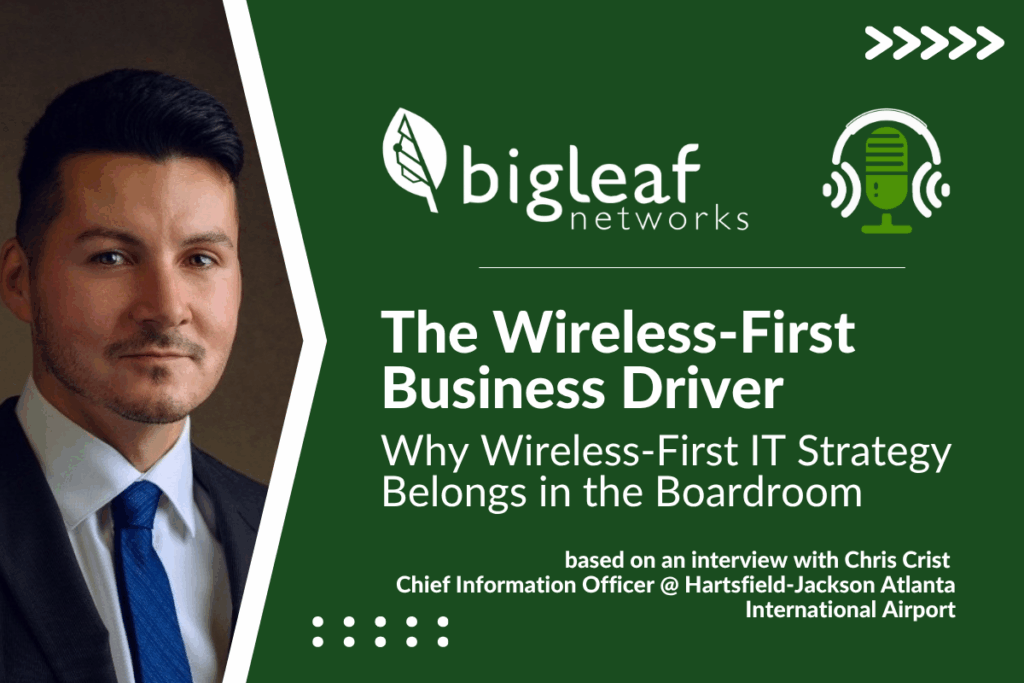The Wireless-First Business Driver
Why Wireless-First IT Strategy Belongs in the Boardroom
At Hartsfield-Jackson Atlanta International Airport, technology doesn’t just support operations—it enables them. With over 108 million passengers moving through the airport each year, CIO Chris Crist believes that a wireless-first IT strategy is no longer optional. It’s the foundation for scale, security, and growth.
In Episode 17 of Go Beyond the Connection, Chris shares how ATL’s network architecture evolved beyond the limits of physical cabling to embrace a wireless-first model. That pivot unlocked biometric boarding, AI-powered security, and a future-ready approach to IT leadership—without needing a square foot of additional facility space.
Strategic IT Means a Seat at the Table
Chris doesn’t just talk technology—he talks alignment. When evaluating CIO roles, he insists they report directly to the CEO. At ATL, that alignment with CEO Ricky Smith ensures that every infrastructure decision supports long-term enterprise strategy.
“I won’t take a job unless I feel we have a seat at the table,” Chris explains. “It’s an organization that views technology as more of a strategic partner versus one that views it as a tactical initiative.”
This seat at the table enables the IT team to drive transformation, not just maintain systems. That’s a core pillar of a wireless-first IT strategy.
From Physical Constraints to Wireless Scale
With no more space to run physical cables into the main data center, Chris and his team needed a new path forward. Rather than rebuild, they reimagined—investing in high-capacity distributed antenna systems and next-gen Wi-Fi across ATL’s terminals.
“We literally could not run any more physical cabling,” Chris says. “We have to rely more on wireless capability.”
That shift now supports over 24,000 simultaneous passenger connections and thousands of IoT sensors across the airport’s smart infrastructure.
Biometric Boarding That Starts with Network Resilience
One of ATL’s most high-impact upgrades is biometric boarding, developed in partnership with Delta. Instead of scanning a boarding pass, international travelers board using facial recognition—saving precious seconds per passenger.
“For an organization that sees 300,000 passengers per day, seconds make a big difference,” Chris shares.
But the seamless passenger experience only works if the network delivers. That’s why these biometric systems, AI overlays, and internal operations all rely on a resilient wireless-first foundation.
Smarter Security Through AI + Wireless
Chris’s team is applying AI to ATL’s network of 7,000 CCTV cameras, enabling near-instant footage filtering and object detection in emergencies.
“With AI, you can filter within seconds to the exact location of an individual,” he explains.
This transition from reactive to proactive safety would be impossible without a wireless infrastructure built for scale, speed, and nonstop uptime.
Wireless-First IT Strategy as a Growth Enabler
Chris Crist’s leadership reframes infrastructure as a strategic lever—not a sunk cost. His wireless-first IT strategy prioritizes resilience, scalability, and alignment across departments.
For CIOs planning for modernization, the message is clear:
- Lead from the C-suite, not the server room.
- Design infrastructure around business goals, not just devices.
- Invest in wireless-first networks that adapt, recover, and scale.
“It’s through technology that we’re going to make that work—and we’ll need to rely more on wireless capabilities to do that.” – Chris Crist
Let’s Go Beyond the Connection – Check out our podcast homepage
🎧 Listen to the full conversation
▶️ Watch more episodes
📬 Subscribe to the LinkedIn newsletter
🎙️ Audio-only feed on Captivate
Go Beyond the Connection Episode 17 with Chris Crist:
Related Links:
